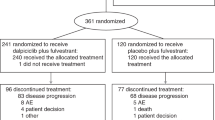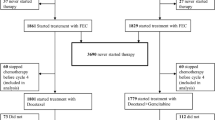Abstract
On the basis of the overexpression of theMDR1 gene in human colorectal cancer, which may constitute a molecular basis for intrinsic drug resistance that can be reversed, and because of the limited therapeutic value of conventional cytotoxic treatment in this common disease, the present phase II study of P-glycoprotein-directed double modulation was initiated. Fifteen patients with measurable metastatic colorectal cancer, all of whom were refractory to first-line chemotherapy with 5-fluorouracil/leukovorin, were entered in this trial. Treatment consisted of 80 mg tamoxifen twice daily on days 1–9, oral dexverapamil every day on days 7–9, and 60 mg/m2 doxorubicin given by intravenous bolus injection on day 8. Courses were repeated every 4 weeks. After a median of three (between one and six) courses, none of the 14 evaluable patients had objective response, and 4 had stable disease. Adverse reactions consisted mainly of myelosuppression (WHO grade IV granulocytopenia was noted in 40%), and mild and reversible dexverapamil-related cardiovascular side-effects, specifically hypotension (47%). Our results suggest that, despite the histological demonstration of high levels of P-glycoprotein in colorectal cancer and administration of two potentially synergistic chemosensitizers, we were unsuccessful in circumventing its primary resistance to chemotherapy.
Similar content being viewed by others

References
Beck WT, Danks MK, Wolverton JS (1994) Resistance of mamillian tumor cells to inhibitors of DNA topoisomerase II. Adv Pharmacol 29B:145–169
Berman E, Adams M, Duigou-Osterndorf R, Godfrey L, Clarkson B, Andreeff M (1991) Effect of tamoxifen on cell lines displaying the multidrug-resistance phenotype. Blood 77:818–825
Chu E, Drake JC, Koeller DM (1991) Induction of thymidylate synthase associated with multidrug resistance in human breast and colon cancer cell lines. Mol Pharmacol 39:136–143
Elliott HL, Meredith PA (1993) Dexverapamil: circumventer of multidrug resistance. In: Eichelbaum M, Hirth HP, Schumacher K, Traugott U (eds) Clinical pharmacological studies with R-verapamil. Kluver Hingham, pp 43–50
Fabian C, Sternson L, Bennett M (1980) Clinical pharmacology of tamoxifen in patients with breast cancer. Comparison of traditional and loading dose schedules. Cancer Treat Rep 64:765–773
Figueredo A, Arnold A, Goodyear M, Findlay B, Neville A, Normandeau R, Jones A (1990) Addition of verapamil and tamoxifen to the initial chemotherapy of small cell lung cancer. Cancer 65:1895–1902
Fojo AT, Ueda K, Slamon DJ, Poplack DG, Gottesman MM, Pastan I (1987) Expression of a multidrug resistance gene in human tumors and tissues. Proc Natl Acad Sci USA 84:265–269
German UA, Harding MW (1995) Chemosensitizers to overcome and prevent multidrug resistance? J Natl Cancer Inst 87:1573–1575
Grant CE, Valdimarsson G, Hipfner DR (1994) Overexpression of multidrug resistance-associated protein (MRP) increases resistance to natural product drugs. Cancer Res 54:357–361
Herrmann R, Kant E de (1992) Dexverapamil: circumventer of multidrug resistance. In: Eichelbaum M, Hirth HP, Schumacher K, Traugott U (eds) Modulation of multidrug resistance (MDR) by R-verapamil and P-glycoprotein expression in human colon carcinoma xenotransplants. Kluver, Hingham, pp 39–42
Lai GM, Chen YN, Mickley LA, Fojo AT, Bates SE (1991) P-glycoprotein expression and schedule dependence of Adriamycin cytotoxicity in human colon carcinoma cell lines. Int J Cancer 49:696–703
Mentges B, Gutt CN, Bülow M (1990) Zum Steroidhormonrezeptorstatus kolorektaler Karzinome. Onkologie 13:13–21
Mülder HS, Pinedo HM, Timmer AT, Ramanath Rao B, Lankelma J (1996) Multidrug resistance-modifying components in human plasma with potential clinical significance. J Exp Ther Oncol 1:13–22
Oudard S, Thierry A, Jorgenson T (1991) Sensitization of multidrug-resistant colon cancer cells to doxorubicin encapsulated in liposomes. Cancer Chemother Pharmacol 28:259–265
Pearson JW, Fogler WE, Volker K, Usui N, Goldenberg SK, Gruys E, Riggs CW, Komschlies K, Wiltrout RH, Tsuruo T, Pastan I, Gottesman MM, Longo DL (1991) Reversal of drug resistance in human colon cancer xenografts expressing MDR1 complementary DNA by in vivo administration of MRK-16 monoclonal antibody. J Natl Cancer Inst 83:1386–1391
Pinedo HM, Giaccone G (1995) P-glycoprotein — a marker of cancer-cell behavior. N Engl J Med 333:1417–1419
Raderer M, Scheithauer W (1993) Clinical trials of agents that reverse multidrug resistance. Cancer 72:3553–3563
Ramu A, Glaubiger D, Fuks Z (1984) Reversal of acquired resistance to doxorubicin in P388 murine leukemia cells by tamoxifen and other triparanol analogues. Cancer Res 44:4392–4395
Roninson IB, Chin JE, Choi KG, Gros P, Housman DE, Fojo A, Sehn D, Gottesman MM, Pastan I (1986) Isolation of human mdr DNA sequences amplified in multidrug-resistant KB carcinoma cells. Proc Natl Acad Sci USA 83:4538–4542
Rothenberg ML, Mickley L, Cole D, Balis F, Tsuro T, Poplack D, Fojo A (1989) Expression of the mdr-1/P-170 gene in patients with acute lymphoblastic leukemia. Blood 74:1388–1393
Scheithauer W, Kornek G, Kastner J, Raderer M, Locker G, Depisch D, Pidlich J, Tetzner C (1993) Phase II study of D-verapamil and doxorubicin in patients with metastatic colorectal cancer. Eur J Cancer 29A:2337–2338
Sela S, Husain SR, Pearson JW, Longo DL, Rahman A (1995) Reversal of resistance in human colon cancer cells expressing the humanMDR1 gene by liposomes in combination with monoclonal antibody or verapamil. J Natl Cancer Inst 87:123–128
Stein U, Walther W, Shoemaker RH (1996) Reversal of multidrug resistance by transduction of cytokine genes into human colon carcinoma cells. J Natl Cancer Inst 88:1383–1392
Trump DL, Smith DC, Ellis PG, Rogers MP, Schold C, Winer EP, Panella TJ, Jordan VC, Fine RL (1992) High-dose oral tamoxifen, a potential multidrug resistance-reversal agent: phase I trial in combination with vinblastine. J Natl Cancer Inst 84:1811–1816
Weinstein RS, Jakate SM, Dominguez JM, Lebovitz MD, Koukoulis GK, Kuszag JR, Klusens LF, Grogan TM, Saclarides TJ, Rononson IB, Coon JS (1991) Relationship of the expression of the multidrug resistance gene product (P-glycoprotein) in human colon carcinoma to local tumor aggressiveness and lymph node metastasis. Cancer Res 51:2720–2726
Author information
Authors and Affiliations
Rights and permissions
About this article
Cite this article
Weinländer, G., Kornek, G., Raderer, M. et al. Treatment of advanced colorectal cancer with doxorubicin combined with two potential multidrug-resistance-reversing agents: high-dose oral tamoxifen and dexverapamil. J Cancer Res Clin Oncol 123, 452–455 (1997). https://doi.org/10.1007/BF01372550
Accepted:
Issue Date:
DOI: https://doi.org/10.1007/BF01372550



